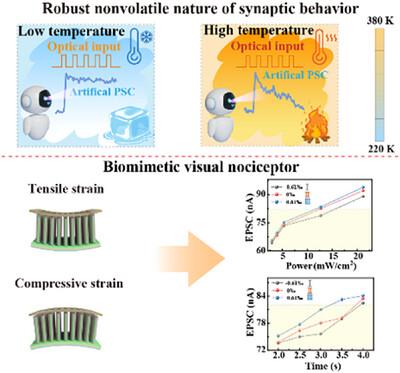双刺激-响应a - GaOx/ZnO异质结纳米线阵列模拟视觉伤害感受器可塑性的人工光电突触
IF 10
1区 物理与天体物理
Q1 OPTICS
引用次数: 0
摘要
具有传感器内视觉感知-记忆-处理的视网膜启发突触装置已经成为复制视觉功能和开发高效神经形态计算的强大实现。然而,单突触装置在双刺激响应特性方面存在局限性,这对高水平整合感知和响应更多感知输入提出了挑战。本文提出了一种基于非晶- GaOx/ZnO异质结纳米线阵列的柔性光电突触器件(FOSD),该器件能够同步感知光和机械信号并将其编码为可编程突触可塑性。此外,从低温220 K到高温380 K, FOSD的突触行为具有强大的非易失性,确保了视觉感知-学习-记忆功能。FOSD对RGB三色光的可区分的宽光谱光响应允许对颜色混合模式进行特征提取,从而提高手写数字识别精度,最高可达90.32%。FOSD强调,利用光力学共刺激方案的应变敏感突触可塑性成为模拟多场景适应性突触活动的基本方法。基于双刺激反应性FOSD的仿生视觉伤害感受器在阈值、敏化、脱敏和非适应等关键特征上呈现出新的调节方式,促进了生物真实感伤害感知系统的发展。本研究为双感统突触装置的设计提供了指导,并为人工视觉伤害感觉系统的环境适应性建立了一个可操作的框架。本文章由计算机程序翻译,如有差异,请以英文原文为准。

Dual Stimuli‐Responsive a‐GaOx/ZnO Heterojunction Nanowire Arrays Artificial Optoelectronic Synapse for Mimicking Visual Nociceptor Plasticity
Retina‐inspired synaptic devices with in‐sensor visual perception‐memory‐processing have emerged as a powerful implementation for replicating visual functionalities and developing highly efficient neuromorphic computing. However, single synaptic devices manifest limitations in dual stimuli‐responsive characteristics, posing a challenge in high‐level integrating perception and response to more sensing inputs. Herein, a flexible optoelectronic synaptic device (FOSD) based on amorphous‐GaOx /ZnO heterojunction nanowire arrays is proposed and enables synchronously perceiving and encoding optical and mechanical signals into programmable synaptic plasticity. Moreover, the robust nonvolatile nature of the FOSD's synaptic behavior from low‐temperature 220 K to high‐temperature 380 K ensures visual perception‐learning‐memory functions. The distinguishable wide spectral photoresponse of FOSD to RGB tricolor lights allows for feature extraction of color‐mixed patterns for improving handwritten digit recognition accuracy up to 90.32%. The FOSD's highlighted strain‐sensitive synaptic plasticity utilizing optic–mechanic co‐stimuli scheme becomes a building block approach to mimic multi‐scenario adaptable synaptic activities. Biomimetic visual nociceptor based on dual stimuli‐responsive FOSD presents novel modulation of key features, encompassing threshold, sensitization, desensitization, and non‐adaptation, enabling the development of bio‐realistic nociceptive system. This work offers guidance for designing a dual‐sensing‐integration synaptic device and establishes an actionable framework for an artificial visual nociceptive system toward environmental adaptability.
求助全文
通过发布文献求助,成功后即可免费获取论文全文。
去求助
来源期刊
CiteScore
14.20
自引率
5.50%
发文量
314
审稿时长
2 months
期刊介绍:
Laser & Photonics Reviews is a reputable journal that publishes high-quality Reviews, original Research Articles, and Perspectives in the field of photonics and optics. It covers both theoretical and experimental aspects, including recent groundbreaking research, specific advancements, and innovative applications.
As evidence of its impact and recognition, Laser & Photonics Reviews boasts a remarkable 2022 Impact Factor of 11.0, according to the Journal Citation Reports from Clarivate Analytics (2023). Moreover, it holds impressive rankings in the InCites Journal Citation Reports: in 2021, it was ranked 6th out of 101 in the field of Optics, 15th out of 161 in Applied Physics, and 12th out of 69 in Condensed Matter Physics.
The journal uses the ISSN numbers 1863-8880 for print and 1863-8899 for online publications.

 求助内容:
求助内容: 应助结果提醒方式:
应助结果提醒方式:


